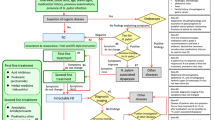Abstract
Dysphagia is a manifestation of several clinical conditions of diverse origin. In spite of the variation in these disease entities in terms of their etiology, clinical presentation, natural history, and treatment, the mechanism of this clinical complaint is not always clear. We studied a group of patients with dysphagia for solids in whom no anatomic or motor abnormalities were encountered on standard studies. The group consisted of 37 patients, 25 women and 12 men, who were complaining of dysphagia of 6 months or longer duration and they did not demonstrate structural or motor abnormalities on barium esophagogram, esophagoscopy, and standard esophageal manometry. A group of 24 age-matched patients, 14 women and 10 men, with noncardiac chest pain served as the patient control. Esophageal contractile activities were studied after 10 wet swallows (5 ml of water) and 10 viscous swallows (5 cubic cm of marshmallow). Resting lower esophageal sphincter pressure and its relaxation response to swallows, amplitude of peristaltic activities, rate of dysphagia provoked during the study, and the frequency of abnormal esophageal contractions were evaluated. Six abnormal esophageal contractile activities—failed peristalsis, dropout, repetitive, simultaneous, spontaneous contractions, and aperistalsis—were utilized to generate an esophageal peristaltic dysfunction index. The mean LESP was 8.1±4.7 in the dysphagia group and 16.1±4.3 in the chest pain group. The mean amplitude of peristaltic contractions was 47.1±16.1 and 89.0±27.0 mmHg after wet swallows for dysphagia and chest pain groups, respectively. These values were 58.2±12.4 and 92.4±22.1 for viscous swallows. Swallowing provoked dysphagia in 89% of the dysphagia group after viscous swallows and 9% after wet swallows. In contrast, only 11% and 3% of control group complained of dysphagia during the study. This group of patients probably represent a cohort of patients with a nonspecific esophageal motor disorder in whom both clinical symptom and their esophageal motor counterpart can only be elicited in response to viscous swallows. We strongly believe in addition of viscous swallows in evaluating dysphagic patients in whom symptoms remain unexplained in light of standard studies.
Similar content being viewed by others
References
Cohen S, Lipschutz W: Lower esophageal sphincter dysfunction in achalasia. Gastroenterology 61:814–820, 1971
Richter JE, Castello DO: Diffuse esophageal spasm: a reappraisal. Ann Int Med 100:242–245, 1984
Cohen S: Motor disorders of the esophagus. NEJM 301:184–192, 1979
Katz PO, Dalton CB, Richter JE, Wu WC, Castell DO: Esophageal testing of patients with no cardiac chest pain or dysphagia: result of three years' experience with 1161 patients. Ann Intern Med 106:593–597, 1987
Halpert RD, Feczko PJ, Spinckler EM, Ackerman LV: Radiological assessment of dysphagia with endoscopic correlation. Radiology 157:599–602, 1985
Hollis JB, Castell DO: Effect of dry swallows and wet swallows of different volumes on esophageal peristalsis. J Appl Physiol 33:1161–1164, 1975
Mellow MH: Esophageal motility during food ingestion: a physiologic test of esophageal motor function. Gastroenterology 85:570–577, 1983
Orlando RC, Bozymski EM: The effects of pentagastrin in achalasia and diffuse esophageal spasm. Gastroenterology 77:472–477, 1979
Donnor MW, Jones B: (Editorial) Gastrointest Radiol 10:194–195, 1985
Allen ML, Orr WC, Mellow MH, Robinson MG: Water swallows versus food ingestion as manometric tests for esophageal dysfunction. Gastroenterology 95:831–833, 1988
Author information
Authors and Affiliations
Rights and permissions
About this article
Cite this article
Meshkinpour, H., Eckerling, G. Unexplained dysphagia: Viscous swallow-induced esophageal dysmotility. Dysphagia 11, 125–128 (1996). https://doi.org/10.1007/BF00417902
Issue Date:
DOI: https://doi.org/10.1007/BF00417902




